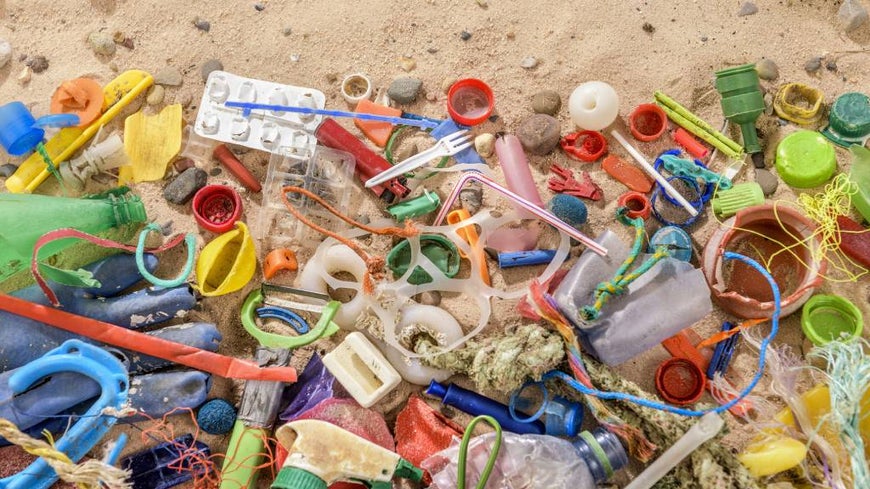The path away from plastic

Written by Pip Harry for Australian Seniors.
For those of us with even a hint of concern about plastic packaging, a visit to the supermarket can be disheartening. Shrink-wrapped cucumbers, vacuum-sealed single steaks and household products in shiny coatings. However, a growing concern for the environment and the future of our grandchildren means changes are afoot.
Australia has set targets for 70% of plastic packaging to be recycled or composted by 2025, along with the phaseout of problematic and unnecessary single-use plastic packaging. “Banning these harmful single-use plastics is one of the most effective things governments can do, because it stops unnecessary plastics at the source,” says Shane Cucow, plastics campaign manager at the Australian Marine Conservation Society.
There are encouraging signs that these goals are achievable, with supermarket giant Woolworths recently announcing an end to plastic bags at the checkout and the NSW government enforcing a ban on single-use plastic bags in June 2022, with more bans rolling out later in the year.
People turning away from excess plastic
Public opinion is increasingly turning against plastic and the 2021 United Nations Climate Change Conference (COP26) saw the formation of a new Global Plastics Policy Centre, with the aim of tackling plastic pollution.
“The Global Plastics Policy Centre is a new research institute that will be conducting first-of-its-kind analysis of plastic policies in countries across the globe,” says Shane. “With many different countries seeking to tackle plastic pollution in different ways – such as bans, levies on plastic packaging, extended producer responsibility schemes and more – it’s important to assess their impact and find out which strategies are proving to be the most effective.”
An even more important global development is the move to establish a global plastics treaty. “At the UN Environment Assembly in February, a landmark resolution was passed to begin negotiations on a new global agreement to end plastic pollution,” says Shane. “Like a ‘Paris Agreement for plastic’, this will be a mammoth game-changer, with binding targets for plastic reduction and funding for poorer nations, bringing the world together for the first time to chart a pathway beyond plastic.”
It’s not just the planet’s health that’s at risk, with microplastics and nanoplastic particles being ingested and inhaled by humans through contaminated products, foods and air. A study done by Australia's Nuclear Science and Technology Organisation (ANTSO) found that the toxicology of engineered nanoparticles might suggest that these particles can easily get access (as well as mobility) within the human body. This is a problem, as they can also bypass some of the body’s inbuilt defense mechanisms. Essentially, nanoplastics interact with our blood plasma proteins as well as other biological molecules inside our bodies. So, is this a problem?
“At this point there is insufficient evidence as to whether it is impacting human health,” says Shane. “What we do know is there is a real risk that we are ingesting plastic particles, and it should be a cause for concern.” This is a point of interest and there are continuing studies underway by ANTSO to determine exactly what the correlation between plastic and our health is, as well as the potential impacts.
Playing our part in the fight against plastic
It’s easy to feel overwhelmed by the current state of plastic pollution, but our day-to-day choices are vital. “Every little bit helps,” says Shane. “Every time we choose reusable options, we send a powerful signal to companies about what we want to see them doing.”
No change is insignificant, adds Pip. “By making small lifestyle changes, we can all help to reduce the impact of waste on our planet and create more sustainable homes. At Clean Up Australia we love this quote [from sustainable chef Anne-Marie Bonneau]: ‘We don’t need a handful of people doing zero waste perfectly, we need millions of people doing it imperfectly.’”
“Behaviour change is critical as our throwaway culture is not sustainable,” says Dr Lau. “We need to change our relationship with plastic, including avoiding single-use plastics and treating plastic waste as a resource.”
Journalist Kate Hughes lives a ‘zero-waste life’ with her family. Here are her expert tips.

We went zero waste overnight one day almost five years ago. We didn’t know it then, but it was the beginning of a total overhaul of every aspect of our lives.
I put my foot through an outdoor beanbag that spilled its polystyrene plastic guts into our beloved little garden. Because I hadn’t really thought about what we were buying – past the fact that it was a cheap and cheerful way of brightening up a neglected patio – I’d caused thousands of years’ worth of pollution.
We started with food, cutting out all purchases that came in plastic packages. That meant ditching the big weekly supermarket shop, sourcing all our food either loose, in bulk-buy sacks or boxes that are returned to be refilled, or by taking our own old glass jars and tins to refill shops.
We cook everything from scratch. And I really do mean everything.
Takeaways and bought snacks disappeared too. It took about three months to retrain
our brains away from automatic purchases, which was tough, but our diet is far better – we’re healthier and fitter, and our food bill is a third cheaper.
But plastic isn’t restricted to the kitchen. Bathrooms are full of it too. Alongside the standard switches to bamboo toothbrushes and toilet roll, metal razors, menstrual cups and reusable nappies, shampoo bars and cardboard-wrapped make-up, we started making our own cleaning products because everything else came in plastic bottles or bags. We learned a lot!
Meanwhile, we were hunting out and vetoing the other plastics hidden in plain sight, from biros to synthetic clothing. Washing one load of synthetic clothing releases up to 800,000 microfibres into the water system, which is pretty horrific.
Ditching plastic was a hugely empowering process that opened the floodgates for us. From there we just kept dialling it up – from switching to a seasonal, local, plant-based diet, to buying an electric car and sourcing what we need second-hand.
We had no idea what ‘zero waste’ meant when we started this journey, but we quickly learned that it means sending nothing to landfill. We haven’t had a bin for years because there isn’t anything to go in it!
We are in charge of the purchasing and other consumption decisions we make every day, nobody else. In the face of the increasingly devastating climate news now coming at us all on a daily basis, it’s a great way to counter climate anxiety too. Reducing your plastic use might even save you money.
Pip Kiernan’s 6 ‘easy wins’ for reducing plastic waste
- Place a reusable bag next to your bins to collect soft plastics for recycling. Grab it when you head to the shops to throw it in the REDcycle bins at the front of Woolworths and Coles supermarkets. This ensures that all your ‘scrunchable plastics’ – bread, rice and pasta bags, biscuit and chip packets, ice-cream wrappers plus the DARE magazine wrapping – can go on to lead a second life, made into road surfaces or outdoor furniture.
- Look for products that use the Australasian Recycling Label, to identify how easily items can be recycled. When we dispose of our waste correctly, we keep contamination out of the recycling stream and recyclable material away from landfill. Greenius is a free, online learning platform that takes the confusion out of recycling.
- Swap your bathroom products with plastic packaging-free alternatives. Most products – from hair care to skin care and cleaning products – now come in bar or tablet form, with just cardboard for packaging.
- Use silicone or beeswax reusable food covers to avoid wasteful single-use plastic wrap. If you need containers for leftovers, look for glass and plastic- free alternatives. Invest in stainless-steel bento boxes or plastic-free lunch boxes and food wraps to pack a waste-free ‘naked’ lunch.
- Keep your reusable coffee cup and drink bottle in your bag and car, so you’re not caught out when you’re thirsty. Step this up and add a reusable straw and cutlery set, so if you’re grabbing food on the go, you’re not reliant on single-use utensils.
- Pack a picnic set from plates, cups and utensils you have at home for a plastic-free meal on weekend wilderness adventures. When you’re out and about, don’t forget your reusable water bottle – it’s astonishing how much plastic you can avoid if you keep one with you at all times.
Australian seniors research asks: why do you take part in environmentally conscious activities?
- 62%
- I want to set a good example for my family.
- 58%
- I want to leave the planet a better place for the younger generations.
- 31%
- I want to leave behind an environmental legacy.
- 52%
- I want to preserve the planet for the younger generations.
- 45%
- It’s the least I can do to reverse some of the damage done by the older generations.
- 55%
- I want to save some money.
See the full results of The Australian Seniors Series: Leaving a Legacy survey
Plastic ban: state by state
- Ban on lightweight plastic bags – Every state and territory.
- Ban on single use plastic products (straws, cutlery, polyethene food containers) – Every state and territory has schemes in place now, or coming within the next few years, except Tasmania.
- Container deposit schemes (money for returning plastic containers) – Every state and territory. Tasmania and Victoria will launch schemes in late 2022 and 2023 respectively.
- Ban on oxo-degradable plastic products – South Australia.
Recycling myth busting with Pip Kiernan and Shane Cucow
What are common misconceptions about recycling?
According to Pip Kiernan, some 47% of Australians believe that soft plastics can go into kerbside recycling; 26% don’t know that our food containers need to be rinsed before going into recycling; and 15% think that we can just put everything in the recycling bin and it will get sorted out at the recycling facility!
How damaging is ‘wishcycling’ – chucking our rubbish into recycling and hoping for the best?
We have to stop clogging the recycling stream with non-recyclable items. Our aspirational recycling can contaminate an entire batch of recyclables, forcing everything to be sent to landfill.
Do I need to make my recyclables squeaky clean?
Small amounts of food don’t interfere with glass and steel recycling – just scrape solid food scraps out of jars and cans and give your bottles and containers a rinse (no soap needed).
Are paper bags really better than plastic bags?
Plastic is almost always the worst packaging type. We need to be moving to organic and compostable materials such as paper and cardboard, or better yet reusable packaging. For hundreds of years, we survived without plastic and we can do it again.
Are all biodegradable products compostable?
Biodegradable products could be any material which breaks down and degrades in the environment over time – but is it 50 years? 150 years? Who knows! Also, products labelled as biodegradable plastics are sometimes actually oxo-degradable plastics, which are conventional plastics mixed with an additive that when exposed to light or heat breaks down. But then it just fragments into microplastics, which are toxic. This packaging is neither recyclable nor compostable. Always check the label.
27 Nov 2022